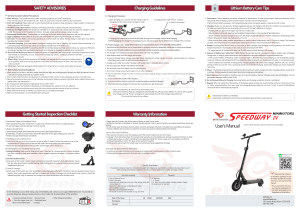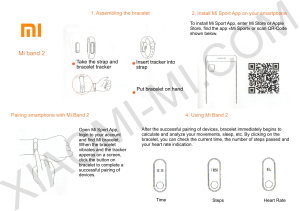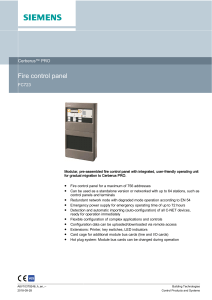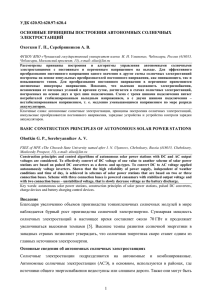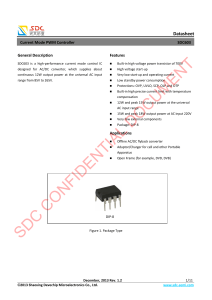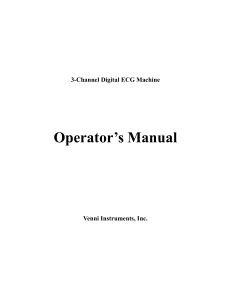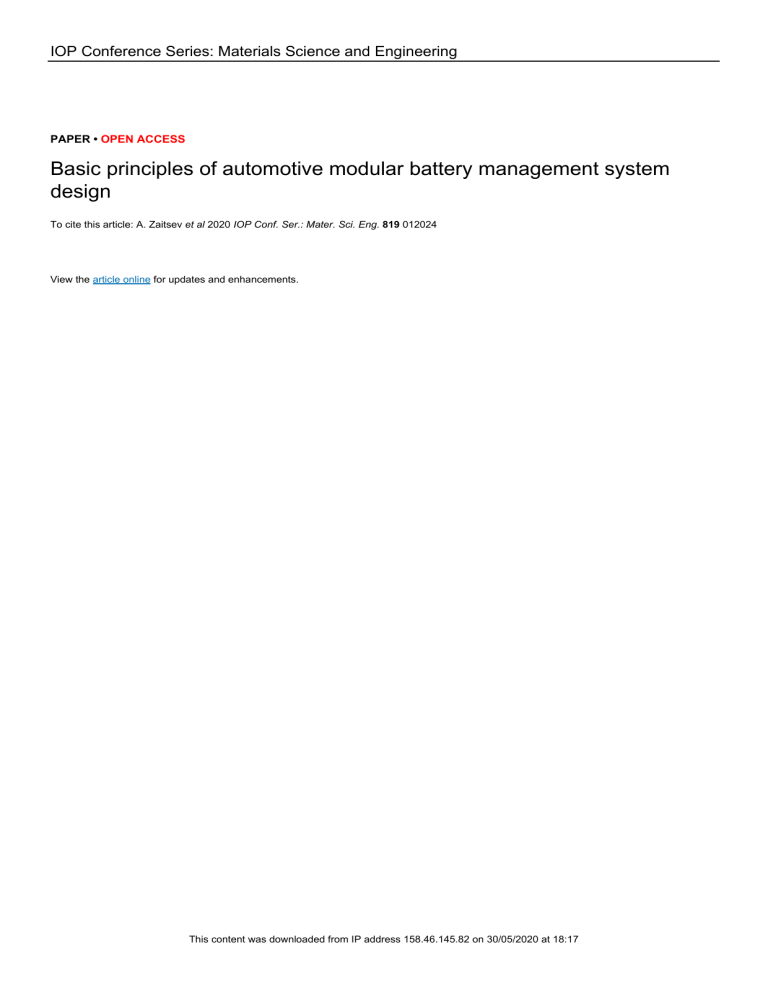
IOP Conference Series: Materials Science and Engineering PAPER • OPEN ACCESS Basic principles of automotive modular battery management system design To cite this article: A. Zaitsev et al 2020 IOP Conf. Ser.: Mater. Sci. Eng. 819 012024 View the article online for updates and enhancements. This content was downloaded from IP address 158.46.145.82 on 30/05/2020 at 18:17 IASF-2019 IOP Publishing IOP Conf. Series: Materials Science and Engineering 819 (2020) 012024 doi:10.1088/1757-899X/819/1/012024 Basic principles of automotive modular battery management system design A. Zaitsev1, D. Butarovich2 and A. Smirnov3 Wheeled Vehicles Department, Bauman Moscow State Technical University, Moscow, Russia E-mail: 1 [email protected], 2 [email protected], 3 [email protected] Abstract. Nowadays, manufacturing of electric vehicles remains one of the most dynamically developing industries all over the globe. The issues of battery efficiency improvement by a suitable battery cell structure selection and battery control system enhancement are of the highest priority in the process of the battery design. Battery management systems (BMS) with modular structure have become the most popular as control systems in electric vehicle battery applications. The paper describes design principles of such type of BMS and necessary hardware. 1. Introduction Nowadays, manufacturing of electric vehicles, mobile energy storage devices and related infrastructure are among the most dynamically developing industries. The transition from internal combustion engine vehicles to hybrid electric vehicles [3, 4, 14, 15] (HEVs) or battery electric vehicles [18] (BEVs) is becoming increasingly apparent. As a result, increasingly stringent demands are made for EV control algorithms [2] and mobile energy storage parameters such as energy efficiency, energy density, charging rate [11], dimensions and mass etc. As the battery management system is required for the most efficient functioning of the modern mobile high voltage energy source, the selection of optimal parameters, layout and structure [1] of both the source itself and the control system is extremely important. But the factors defining the choice are often not obvious. Further we will use the term “battery” to determine an electrical energy source. In this article, the principles and basic hardware for the BMS with modular topology design are listed and also solutions of worldwide famous EVs manufacturers are reviewed. 2. Battery layout Before addressing BMS, we shall give a description of the main structural elements of a battery (see fig. 1). The battery is based on the chemical current source – a lithium-ion cell, which is the simplest structural element of the battery and has a relatively low capacitance and voltage (depending on its chemical composition [5]). Today, battery cells are being mass manufactured in 3 form-factors: prismatic cells, cylindrical cells and pouch cells. The form of the cells largely affects the battery mass and dimensions and also defines the layout of the battery cell assemblies described further. Several cells connected in parallel form an element. A series of connected elements form a subpack. Content from this work may be used under the terms of the Creative Commons Attribution 3.0 licence. Any further distribution of this work must maintain attribution to the author(s) and the title of the work, journal citation and DOI. Published under licence by IOP Publishing Ltd 1 IASF-2019 IOP Publishing IOP Conf. Series: Materials Science and Engineering 819 (2020) 012024 doi:10.1088/1757-899X/819/1/012024 Figure 1. Basic structural parts of the battery. Subpacks are usually connected in series and placed in a common housing to achieve the voltage required by the traction motor. A possible traction battery configuration of the electric vehicle is shown in figure 2. As a rule, the module consists of a subpack series, thermal management equipment [13, 17] and a power distribution unit (PDU), which performs the functions of safe load connection and disconnection, precharge of high voltage circuit in the process of connection and communication with the vehicle control unit (VCU). Any of the structural components described above can be expressed by the formula NpMs, where N is the number of cells connected in parallel in each element and M is the number of elements connected in series (for example 3p4s, 3p88s, 1p10s, etc.). So, NxM equals to the total cell number in the specific structural component of the battery. Note that the described terms are not universally accepted and vary from manufacturer to manufacturer. Often, additional intermediate structural elements are added. Nevertheless, the described principles of the battery cell layout are general [6]. Figure 2. A possible traction battery configuration of the electric vehicle (subpack formula here is 2p10s, module formula is 2p50s, battery formula 2p150s). 2 IASF-2019 IOP Publishing IOP Conf. Series: Materials Science and Engineering 819 (2020) 012024 doi:10.1088/1757-899X/819/1/012024 3. Modular BMS Modular BMS [12] have become most popular because of their good expandability (a possibility to connect additional structural elements to the battery system). A modular BMS consists of the following structural elements [7]: 1) master controller, 2) slave controller, 3) additional control units, 4) communication channel “Vehicle-Master”, 5) communication channel “Master-Slave”. Possible layout of the listed structural element inside the battery is shown in figure 3. Usually, each subpack has its own Slave controller and the Master is a part of the PDU [10]. Proximity of Slaves to lithium-ion cells and the Master to the power control devices of the PDU combines well with the functions of these controllers, which are described further. Note that the shown layout is widely used and easy to understand but it’s not the only possible variant. Battery manufacturers often combine different components, for example a Master and a Slave on the same PCB, or use subpacks with different voltages, etc., based on characteristics and form of the battery. Figure 3. Layout of the main elements of the modular BMS in a battery. 4. Master controller Master controller implements “high-level” functions. This term means that the controller doesn’t work with the battery cells directly but collects and analyses the information received from the Slave controllers. Based on this information, the master invokes algorithms that connect/disconnect the load to the battery, charge the battery, protect it, etc. To implement the described functions, the master controller is directly connected with the following control devices located in the PDU: main HV switches (contactors) S1 and S2, precharge contactor S3 and current sensor A1 (fig. 4). The figure also shows High voltage measurement units (V1 and V2) and the Insulation Control Unit (ICU). Manual Service Disconnection device (MSD) S4 allows the user to disconnect the HV circuit manually in the process of maintenance. The process of the battery load connection follows this algorithm: 1) receiving the battery load connection request via the Vehicle-Master channel, 2) battery cells state test (diagnostics of voltage, temperature, etc.), 3) start of precharge session (in case of faults absence), 3 IASF-2019 IOP Publishing IOP Conf. Series: Materials Science and Engineering 819 (2020) 012024 doi:10.1088/1757-899X/819/1/012024 precharge contactor (S3) closing, negative pole main contactor (S2) closing, 4) waiting for 90-95% equalization of battery and load voltage, 5) positive pole main contactor (S1) closing; 6) precharge contactor (S3) opening. Figure 4. PDU schematics: S1, S2 – main HV contactors, S3 – precharge contactor, S4 – Manual Service Disconnection device (MSD), R1 – precharge resistor, F1 – fuse, A1 – current sensor, V1 – battery output HV measurer, V2 – load HV measurer, ICU – Insulation Control Unit. Precharge process in this algorithm is necessary. Because of the capacitance of load (of traction invertor, of DC-DC convertors, etc.), main contactor closing without precharge will cause a very high peak current at the first moment. The occurrence of such a current can lead to critical failures of the main contactors (for example, to contact welding). During the execution of this algorithm, every stage goes with control of Slaves faults, battery current, high voltage circuit insulation and state of switches (S1, S2, S3). 5. Slave controller A slave controller is a device which implements “low-level” functions. This means that each Slave controls battery cells balancing, measures cell voltage, monitors and calculates the cell parameters such as SOC (State of Charge) and SOH (State of Health), monitors cell faults, etc. Schematics of the Slave controller is usually more complicated than the schematics of the Master controller because of the connection of large amount of cells (up to several dozens) to one PCB. As a rule, Slave controller power supply is provided directly from the connected cells so that the energy consumption is evenly distributed between the cells, therefore the supply voltage can be up to several tens of volts. Another important problem is that we have to measure voltage differentially for every cell. A conventional controller cannot provide such functionality so special cell monitoring ICs are used in these applications, some of them are listed in table 1 (also see [3]). That means the microcontroller which implements algorithms of balancing, voltage measurement, etc. is required to work in conjunction with the described ICs. Such ICs have a special interface (SPI, UART, etc.) to exchange the monitoring data with the microcontroller using a special protocol. Also the microcontroller must communicate with other BMS controllers and vehicle devices via automotive interfaces such as CAN, automotive Ethernet or others. 4 IASF-2019 IOP Publishing IOP Conf. Series: Materials Science and Engineering 819 (2020) 012024 doi:10.1088/1757-899X/819/1/012024 Table 1. Lithium-ion cell monitoring ICs. Number of connected cells Max. number of devices in daisy chain Possible chemical composition of connected cells 6..16 16 All types BQ76PL536 3..6 32 All types TC6801 up to 12 16 All types up to 12 16 All types LTC6804 up to 12 16 All types LTC6813 up to 18 16 All types Model Manufacturer BQ76PL455 TI LTC6802 Linear Tech. L9763 LG Chem ISL78600 ISL94202 up to 10 No available data up to 12 Renesas ISL94208 3..8 No available data LCO, LMO, LFP 4..6 MC33771 NXP 7..14 No available data All types D15110 (NEC) Renesas 4 32 No available data T2-A2 PZ38984 Tesla No available data Note that the ICs shown in table 1 don’t include any programmed algorithm for the working with the cells (for instance, a balancing algorithm). These ICs can measure the voltage of each connected cell, process readings of the temperature sensors, operate as triggers and signal when the voltage is outside the allowable range on one or several cells, as well as control external balancing circuits. As a rule, such a connection of the microcontroller with one or several specialty chips is organized as it is shown in figure 5. Each Slave contains one microcontroller and one, two or more daisy chained cell monitors. As it is shown in table 1, most cell monitoring ICs are able to be connected in daisy chain up to 32 ICs over differential galvanically-isolated interface. In practice topologies with one or two CM are most popular. This choice is based on high reliability requirements for Slave. Obviously, the large number of cell monitors connected in a daisy chain increases fault probability and the time of data reading and writing. As it was noted before, one of the main functions of the Slave controller is charge balancing [16]. The balancing function provides the most efficient use of the battery energy by keeping the state of charge of the cells approximately equal. The difference between the SOC of the cells in same operation conditions appears because of the inequality of the cells leakage currents [8] due to small cell-to-cell manufacturing process variations. Nowadays, two types of battery cells balancing are used: passive and active balancing. 5 IASF-2019 IOP Publishing IOP Conf. Series: Materials Science and Engineering 819 (2020) 012024 doi:10.1088/1757-899X/819/1/012024 a) b) c) Figure 5. Slave module layout options: a – one cell monitor on each Slave; b – daisy chain of two cell monitors on each Slave; c – daisy chain of several ICs on each Slave. In case of passive balancing the Slave controller finds the cells having the highest charge and connects them to the balancing load to decrease their SOC by converting the cell energy to heat (fig. 6). Advantages of passive balancing are relative simplicity of design and balancing control algorithms. Main disadvantage is inefficient energy to heat conversion. a) b) Figure 6. Passive balancing. (a) – electric circuit diagram; (b) – balancing process. With active balancing the energy can be redistributed inside the battery, while the energy from the cells with a high charge level is transferred to the cells with a low charge level. Active balancing can be used in both charge and discharge processes. Active circuits are divided into 3 types according to implemented principles of balancing: 1) based on capacitors; 2) based on inductors (transformers); 3) based on DC/DC converters. The topology of the active balancing system based on capacitors is shown in figure 7. To equalize the charge between the cells the RC circuit is connected to the cell with the maximum charge (for example, B1 in figure 7b), at that the cell energy partially goes into the capacitor. Then the charged capacitor is being connected to the cell with the minimal charge (for example B3, in figure 7c) and the energy stored in the capacitor partially flows to the cell. The resistor R is used to limit the balancing current. The disadvantage of this method is a long time of charge balancing between all the cells. 6 IASF-2019 IOP Publishing IOP Conf. Series: Materials Science and Engineering 819 (2020) 012024 doi:10.1088/1757-899X/819/1/012024 a) b) c) Figure 7. Capacitive active balancing: a – electric circuit diagram, b – capacitor charging process from cell B1, c – capacitor discharging process to cell B3. The general disadvantage of different active balancing systems is the complexity of the circuit design, which increases the time and price of their development. Obviously, active balancing is more energy-efficient but battery manufacturers often choose the cheaper and easier method of passive balancing. Important criteria of balancing type choice are formed below. 1. Required battery charging time. If the battery charging time is not critical in a specific application (for example, the vehicle is used in the daytime and is being charged at night), passive balancing is the most reasonable choice. In this case charging requires a long time and balancing can be accomplished during this period with a low current not leading to the BMS elements overheating [9]. However, if the charging time is critical (for example, for public transport, charging several times a day) it’s reasonable to use active balancing. 2. Balancing current To assess the possibility of the passive balancing implementation, it’s necessary to define the balancing current, which can be calculated by the following equation: . . (1) is the maximal leakage current, [A]; is where Ib is the balancing current, [A]; . . the minimal leakage current, [A]; is the balancing time during a day, [hours]. Because of one of the main tasks of the BMS while balancing is equalization of the leakage currents for all cells, the data about maximal and minimal leakage currents are necessary. This information can be requested directly from the manufacturers of the cells for accurate calculation. Indirectly, the maximal leakage current can be estimated from the information about the nominal battery storage time. So, for example, if a manufacturer has limited the storage time for a 100 Ah battery by 18 months, then from the following equation: (2) . where C is the nominal battery capacitance [A·h]; tstorage is the nominal storage time, [months], we can = 7,7 mA. get the leakage current . The active cooling of the battery cells and BMS elements also must be taken into consideration. 3. Cost 7 IASF-2019 IOP Publishing IOP Conf. Series: Materials Science and Engineering 819 (2020) 012024 doi:10.1088/1757-899X/819/1/012024 Cost of each BMS Slave controller is directly connected with the number of cells. So with passive balancing, the addition of one cell requires one switch and one resistor for energy dissipation. With active balancing the possibility of connection of one cell to others must be provided. In this case the cost is determined by specific type of active balancing and includes cost of additional capacitors, inducers, voltage converters and special ICs, intended for switching one cell with any other. It’s important to note that the number of cells in a battery is not a determining factor for balancing type choice. Balancing types used in batteries of big manufacturers are listed in table 2. Table 2. Solutions of big manufacturers of EVs. Manufacturer Product model Number of cells Tesla Model S 7104 Tesla Model 3 2170 BMW i3 96 Mitsubishi i-MiEV 88 Nissan Leaf 192 Opel Ampera - Chip model BQ76PL536 (TI) T2-A2 PZ38984 (Tesla) LTC6801 (LT) LTC6802 (LT) D15110 or D15120 (NEC) L9763 (LG Chem) Balancing current Balancing type 9,4 mA Passive - Active 6,6 mA Passive 4,5 mA Passive 8,6 mA Passive - Passive Conclusion Optimal choice of BMS topology and parameters is extremely important in terms of the vehicle maximum range and the lifecycle of the battery cells and other electronic devices. Having analyzed the experience of the world-known manufacturers discussed in the article, we can make a conclusion that the layout of a BMS and the battery itself should be based on the vehicle working cycle, the required mass and, sometimes, the shape of the battery. The following abbreviations are used in this article: BMS – Battery Management System CAN – Controller Area Network CM – Cell Monitor DC – Direct Current ECU – Electronic Control Unit EV – Electric Vehicle HV – High Voltage IC – Integrated Circuit ICU – Insulation Control Unit MSD – Manual Service Disconnect OCV – Open Circuit Voltage PCB – Printed Circuit Board PDU – Power Distribution Unit SOC – State of Charge SOH – State of Health TI – Texas Instruments VCU – Vehicle Control Unit 8 IASF-2019 IOP Publishing IOP Conf. Series: Materials Science and Engineering 819 (2020) 012024 doi:10.1088/1757-899X/819/1/012024 References [1] Zaitsev A S, Butarovich D O and Smirnov A A 2018 Obzor topologiy sovremennih sistem upravleniya zaryadom nakopiteley energii dlyz elektricheskich transportnych sredstv [Modern electric vehicle battery management systems topology review] Zhurnal avtomobilnych ingenerov 109 pp 29-33 [2] Kotiev G O, Butarovich D O and Kositsyn B B 2018 Energy efficient motion control of the electric bus on route IOP Conference Series: Materials Science and Engineering 315 [3] Gorelov V A, Butarovich D O, Staduhin A A and Skotnikov G I 2019 Simulation-based identification of the parameters of a minibus hybrid powertrain IOP Conference Series: Materials Science and Engineering 534 [4] Yaroslavtsev M V 2014 Determination of parameters of a hybrid car powertrain by modeling of the energy consumption process Russian Electrical Engineering 85 (12) pp 724-728 [5] Semenenko M G 2009 Visual modelling electrochemical processes Journal of Power Sources 191 (1) pp 91-96 [6] Lelie M, Braun T, Knips M, Nordmann H, Ringbeck F, Zappen H nad Sauer D U 2018 Battery management system hardware concepts: An overview Applied Sciences (Switzerland) 8 (4) [7] Abronzini U, Attaianese C, Monaco M D, Porpora F, Tomasso G, Granato M and Frattini G 2019 Optimal Modular BMS for High Performances NMC Battery Pack 2018 IEEE International Conference on Electrical Systems for Aircraft, Railway, Ship Propulsion and Road Vehicles and International Transportation Electrification Conference ESARS-ITEC 2018 [8] Redondo-Iglesias E, Venet P, Pelissier S 2018 Global model for self-discharge and capacity fade in lithium-ion batteries based on the generalized eyring relationship IEEE Transactions on Vehicular Technology 67 (1) [9] Xia B, Zhou J, Yang Y, Wang H, Wang W and Lai Y A 2019 Novel Battery Equalization Method Base on Fuzzy Logic Control Considering Thermal Effect IOP Conference Series: Earth and Environmental Science 300 (4) [10] Bauer M, Muehlbauer M, Bohlen O, Danzer M A and Lygeros, J 2019 Power flow in heterogeneous battery systems Journal of Energy Storage 25 [11] Wu S.-T, Chang Y.-N, Chang C.-Y and Cheng Y.-T 2019 A fast charging balancing circuit for LiFePO4 battery Electronics (Switzerland) 8 (10) [12] Liu B, Liu M, Jiang X, Tuo X, Zhou H and Ren J 2018 Design of battery management system based on DSP for BEV Proceedings of 2017 9th International Conference On Modelling, Identification and Control, ICMIC 2017 pp 857-862 [13] Suthar B, Sonawane D, Braatz R D and Subramanian V R 2015 Optimal low temperature charging of lithium-ion batteries IFAC-PapersOnLine 28 (8) pp 1216-1221 [14] Alfieri L, Bracale A, Caramia P, Iannuzzi D and Pagano M 2019 Optimal battery sizing procedure for hybrid trolley-bus: A real case study Electric Power Systems Research 175 [15] Herrera V I, Milo A, Gaztanaga H, Ramos and Camblong H 2019 Adaptive and Non-Adaptive Strategies for Optimal Energy Management and Sizing of a Dual Storage System in a Hybrid Electric Bus IEEE Transactions on Intelligent Transportation Systems 20 (9) [16] Feng F, Hu X, Liu J, Lin X and Liu B 2019 A review of equalization strategies for series battery packs: variables, objectives, and algorithms Renewable and Sustainable Energy Reviews 116 [17] Deng T, Ran Y, Yin Y, Chen X, Liu P 2019 Multi-objective optimization design of double-layered reverting cooling plate for lithium-ion batteries International Journal of Heat and Mass Transfer 143 [18] Jung H, Silva R and Han M 2018 Scaling trends of electric vehicle performance: Driving range, fuel economy, peak power output, and temperature effect World Electric Vehicle Journal 9 (4) 9 IASF-2019 IOP Publishing IOP Conf. Series: Materials Science and Engineering 819 (2020) 012024 doi:10.1088/1757-899X/819/1/012024 Acknowledgments The research was carried out at BMSTU with the financial support of the Ministry of Education and Science of the Russian Federation under Agreement 14.574.21.0178 (Unique identifier: RFMEFI57417X0178). 10


